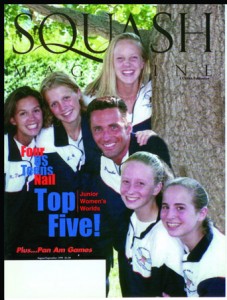
By Jay D. Prince
Ten years and 100 issues of Squash Magazine. Seems hard to believe, especially in light of the fact that it almost never even got off the ground. In fact, had things gone the way I’d originally hoped, Squash Magazine would be looking in the rear view mirror at year number 10 as we enter our 14th year. Why? Because it was actually back in 1994 that I first started approaching the USSRA (now, of course, US Squash) about the possibility of getting behind a new magazine for the sport.
I had just shut down a magazine for the sport of Junior Tennis that a friend and I launched and ran for nearly three years, and I was looking for a new challenge. Junior Tennis had a circulation of 50,000 and was printed five times each year. After its demise, it didn’t take long for me to set my sights on squash, partly because I was an avid player, and partly because I felt the sport deserved something more along the lines of what Sports Illustrated is for all the major sports. While I’m not naive enough to say that Squash Magazine could hold a candle to Sports Illustrated, that wasn’t really the point. At the time the idea began to germinate, there were really only two publications that were actively produced for squash—Squash News and Squash Player.
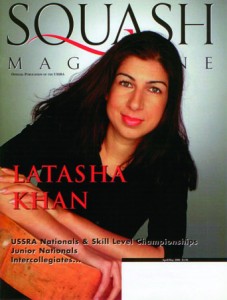
Many of you will recall Squash News because you used to receive it as a benefit of your membership in the USSRA. It was a tabloid newsprint product that was printed 10 times each year, just like this magazine. Squash News was produced by Tom and Hazel Jones who had done so many positive things for the sport of squash, including developing and hosting a number of tournaments, most notably the US Open and the North American Open. For over ten years, Tom and Hazel did more for the promotion of squash in the US than anyone
Squash Player (the magazine from England), at that time, had morphed itself into a pocket-size color publication and was primarily focused on international squash. Nearly all of the magazine was focused on the professional game.
The opportunity I saw was simply that squash is an active sport that warranted action photography. So that’s what I proposed to the USSRA. While it was never my intention to put Squash News out of business, that fate was probably guaranteed when Squash Magazine was finally awarded the contract to provide it to the members of the USSRA—the second time I tried.
One thing I was very aware of was that Squash Magazine was going to be unpopular with many who had supported Squash News for so long. From players to advertisers, Squash Magazine was met with a lot of resistance. I know of one advertiser who said to another, “You’re not going to advertise in that new magazine are you? How can you do that to Tom and Hazel?” In fact, the only company to commit to a full-page color ad in any of our first nine issues was Prince.
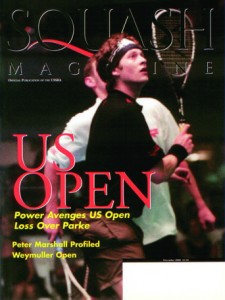
And with the first issue of Squash Magazine, I asked our readers to send us their comments. One of the first I received was, “You wanted feedback. All I have to say about Squash Magazine is bring back Squash News.” Oh boy. But instead of shrugging it off, I emailed the person who made that comment and found out that they were disappointed that we weren’t running full results of tournaments in the back of the magazine. I made that decision based on the expense of adding more pages to accommodate those results. It was just cost prohibitive. And look where we’re at now with the internet and instantaneous results anytime you want them.
To be honest, if it hadn’t been for the endorsement of the USSRA, I’m not sure we’d have made it out of our first year. I recently took a look back at the ten issues we printed in our first year, and the paucity of advertising was borderline embarrassing. But I expected it when we started, and by the end of that first year, we had finally started making some inroads—that’s when Ashaway purchased their first full-page ad.
But what I remember most about that first year was that with a full-time staff of two, including myself, we managed to print the ten monthly issues and were off and running; and I logged more all-nighters than I care to recount. The most humorous of those all-nighters came when I followed one up with red-eye heading to Boston the next day. The first leg of my flight stopped in Atlanta at about 2:30am Pacific Time. So I quickly found my next gate, sat down about 15 feet from the doorway, propped my feet up and went to sleep. No problem, my flight wasn’t for about two hours anyway. So when my flight was announced, imagine my surprise when I realized I’d been asleep for nearly five hours and missed four different connecting flights to Boston. I guess I was more tired than I thought!
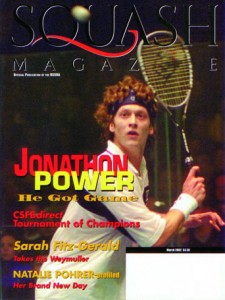
We’re all aware of how things have changed in squash over the past ten years, and the same can be said about the publishing world. The technological advances have been nothing short of mind-boggling. When we started, every picture we took was shot on film. It sometimes took 30-40 rolls of film over the course of a weekend tournament to come up with five photos that were good enough to print. Today, everything we do with photography is digital. It’s not uncommon for photographers to shoot several thousand pictures over a weekend now, and then just delete those that don’t turn out. That in itself reduced the cost of producing the magazine by hundreds of dollars every month.
And the printing process has changed dramatically too. It used to take nearly two weeks from the time we sent our files to our printer to the time the magazine was put in the mail. Today we do it in about eight days. Why? Because we no longer have to produce film or color proofs before printing. Instead, we see proofs online, make any necessary corrections digitally, and send them directly to the printer. And the printer simply creates printing plates for their presses directly from our digital files. That change in the production process has effectively wiped out an entire industry of companies that did nothing but prepare film-based files for the printers—and it cut our printing cost by a third.
But it’s the day to day operations that have perhaps been the most remarkable. One source of information in the squash world, an amazing man named Howard Harding, is based in England, and I receive upwards of 10 emails each day from Howard. And over the course of the last 10 years, I’ve spoken with him only once—at 2am his time when he had just returned from working at a hockey game!
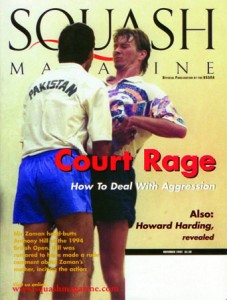
As for my staff, I’ve never employed more than three people at a time, including myself. I started out with a single writer (Kristin Pedroja) who was with me for a little over a year. After three issues, I hired Randall Scott to layout the pages of the magazine. Most of you will remember him as the irreverent photographer who loved traveling to tournaments while masquerading as a squash player. He put in countless hours with Squash Magazine, both as portrait photographer and desktop designer. His brash personality brought some character to our offices and to the sport. In our third year, I hired Amy Boytz (now Duchêne) and Ryan Lewis. Best move I ever made for this magazine.
Amy was phenomenally well-organized and immersed herself in the sport to manage all of our editorial content for about five years. One of the hardest things I’ve had to do is say goodbye to her when her talents landed her a position elsewhere that I just couldn’t afford. I don’t think there was a day when she wasn’t upbeat and eager to move Squash Magazine forward. And Ryan? He’s been working with me for seven years now. He too has been indispensable. He’s managed our advertising and administration better than I could have ever hoped. He too has been a constant source of positive energy with the magazine and I couldn’t do this without his hard work and dedication.
Most recently, Kirsten Carlson spent a little over a year as my editorial assistant. Though she is no longer with the magazine on a full-time basis, she has also gained a foothold in the sport that may continue somewhere on the east coast.
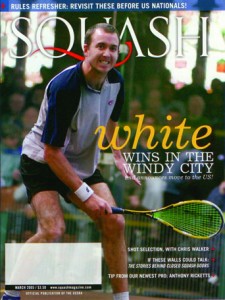
Will Carlin is rapidly approaching his 100th column in the back of the magazine. I can’t think of anyone more passionate about squash than Will. Rod Symington has written nearly 100 articles on the rules. There have been several times when he’s emailed to say that he’s not sure he can come up with anything else to say. But then I turn around and send another dozen ideas and away he goes.
At the end of the day, all I really set out to do with Squash Magazine was to bring the passion for the sport into your homes. We all play this game with intensity every time we walk onto the court. And it’s that intensity that we try to present in the magazine. It’s the reason why there are so many action photos. It’s why we try to offer helpful instruction through the LessonCourt section (and is something I’d love to expand). Squash is an active sport and is deserving of publicity. While we may not yet be considered mainstream, we are making progress. Squash nearly landed on the Olympic program. The explosion of urban programs has been nothing short of amazing. We can watch tournaments on the internet now. Even the Geico Cavemen play squash!
Most of all, it’s the players, coaches, and squash fanatics that I’ve met over the years that have made all of this so fulfilling. At times it feels overwhelming when people walk up to me and say hi, but only because I’ve probably met them before and simply cannot remember everyone. The most bizarre encounter was on a plane when I was travelling with my family for a vacation. Imagine my surprise when one of the passengers walked up to me mid-flight and asked, “Aren’t you Jay Prince with Squash Magazine?” That nearly floored me.
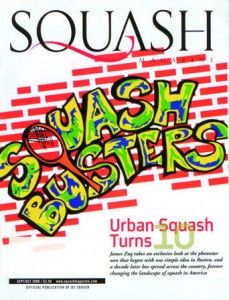
To top it all off, I still try to play this game and enter tournaments. That can make things a bit challenging at times. For example, a few years ago the US Junior Closed and the Adult Nationals were being played on back-to-back weekends at Yale. But instead of just staying in New Haven for ten days, I wanted to spend time with my family back in Seattle between the two events. So I flew out on Friday for the Juniors, flew home late Sunday night, then turned around and flew back on Wednesday. No problem, right? Wrong.
My flight back to Hartford on Wednesday stopped in Minneapolis where I was to change planes. But by the time we got there, a snowstorm forced us to circle for nearly two hours before we had to refuel in Duluth, MN. While in Duluth, the Minneapolis airport opened and closed again, and virtually all of us missed our connections. Once finally on the ground, I called the airline (Silver Elite member, you know) and got booked on another flight to Hartford…that was ultimately cancelled. So I hopped on a plane to Boston (my bags would still go to Hartford), landed after midnight, drove to Hartford and checked into the hotel at 3am. With only my racquet and glasses (that I carry on the plane), I bought some clothes the next morning, got some shoes from Dave Talbott at Yale, and was on one of the glass showcourts playing Chase Lenfest—the court’s namesake—by 11am. Just before I walked on the court, Talbott put his arm around me, pointed at Lenfest’s name above the court and said, “You know, if you win, we’ll have a bit of a problem.” I just replied, “No problem, just replace it with Squash Magazine if I win!” I won 3-0, but Chase’s name is still up there.
Though proud of what we’ve accomplished over the decade, there are many things I’d like to do that will hopefully become reality one day. So please, keep sending your Letters to the Editor with ideas, comments, criticisms and anything else that comes to mind. I read all of them and print most. Here’s to another 10 years!


